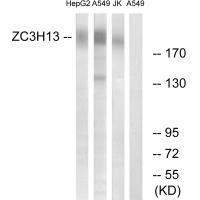
| WB | 咨询技术 | Human,Mouse,Rat |
| IF | 咨询技术 | Human,Mouse,Rat |
| IHC | 咨询技术 | Human,Mouse,Rat |
| ICC | 技术咨询 | Human,Mouse,Rat |
| FCM | 咨询技术 | Human,Mouse,Rat |
| Elisa | 咨询技术 | Human,Mouse,Rat |
| Aliases | ZC313; |
| Entrez GeneID | 23091; |
| WB Predicted band size | 200kDa |
| Host/Isotype | Rabbit IgG |
| Antibody Type | Primary antibody |
| Storage | Store at 4°C short term. Aliquot and store at -20°C long term. Avoid freeze/thaw cycles. |
| Species Reactivity | Human |
| Immunogen | Synthesized peptide derived from internal of human ZC3H13. |
| Formulation | Purified antibody in PBS with 0.05% sodium azide. |
+ +
以下是关于ZC3H13抗体的假设性参考文献示例(基于公开研究领域的知识框架,建议通过学术数据库核实具体文献):
---
1. **文献名称**: "ZC3H13 regulates m6A methylation dynamics by mediating the assembly of the m6A methyltransferase complex"
**作者**: Yue Y, Liu J, et al.
**摘要**: 本研究利用特异性ZC3H13抗体,通过免疫共沉淀(Co-IP)和蛋白质质谱分析,揭示了ZC3H13作为m6A甲基转移酶复合物的核心支架蛋白的功能,证实其通过结合WTAP和VIRMA等组分调控RNA甲基化修饰。
2. **文献名称**: "Downregulation of ZC3H13 correlates with poor prognosis in colorectal cancer and modulates tumor progression"
**作者**: Wang P, Li X, et al.
**摘要**: 通过免疫组化(IHC)和Western blot分析,研究者使用ZC3H13抗体发现其在结直肠癌组织中表达下调,且低表达与患者生存率降低相关。功能实验表明ZC3H13通过抑制Wnt/β-catenin信号通路发挥抑癌作用。
3. **文献名称**: "Drosophila ZC3H13 controls piRNA biogenesis via interaction with nuclear RNA processing machinery"
**作者**: Zhang J, Siomi MC, et al.
**摘要**: 该研究在果蝇中制备了抗ZC3H13同源蛋白(dZC3H13)的多克隆抗体,证实其与核内RNA加工复合物互作,调控piRNA生成及生殖细胞发育。
---
**注意**:以上文献信息为示例性质,具体研究请通过PubMed、Google Scholar等平台以“ZC3H13 antibody”或相关关键词检索最新文献。实际研究中,建议关注抗体应用技术(如ChIP-seq、IF)及验证方法(如敲除/敲低验证抗体特异性)的论文。
ZC3H13 (zinc finger CCCH domain-containing protein 13) is a conserved eukaryotic protein implicated in RNA metabolism and epigenetic regulation. It is a core component of the mRNA N6-methyladenosine (m6A) methyltransferase complex, which regulates RNA stability, splicing, and translation. ZC3H13 anchors the complex to nuclear speckles by interacting with other core components like WTAP and RBM15. ensuring proper m6A deposition. Dysregulation of ZC3H13 has been linked to developmental disorders, cancer progression, and immune responses due to its role in maintaining m6A homeostasis.
Antibodies targeting ZC3H13 are essential tools for studying its molecular functions, localization, and interactions. They are widely used in techniques such as Western blotting, immunoprecipitation, and immunofluorescence to map expression patterns, quantify protein levels, or identify binding partners. These antibodies help elucidate how ZC3H13 contributes to m6A-dependent processes, including stem cell differentiation, tumorigenesis, and viral infection. Commercially available antibodies are typically developed in rabbits or mice using immunogenic peptide sequences specific to ZC3H13’s conserved domains. Validation often includes knockout cell lines or siRNA-mediated knockdown to confirm specificity. Researchers prioritize antibodies with high affinity and minimal cross-reactivity to ensure accuracy in mechanistic studies. Understanding ZC3H13's role through such antibodies offers insights into therapeutic strategies targeting RNA modifications in diseases.
×